PURPOSE This study aimed to identify ACTN3 gene polymorphisms amongprofessional ssireum players by weight class and between elite and non-elite players,and to select genotype that matches the characteristics of the sport. METHODS The subjects of this study were 148 male athletes currently working as professionalssireum players. Chi-square test cross-tabulation analysis was conducted to examinethe differences in ACTN3 genotypes between weight classes and between elite andnon-elite players. RESULTS There were no significant differences in allele or genotypebetween ssireum players, but there were significant differences in R-allele and XXgenotype. CONCLUSIONS Players with the R-allele type of the ACTN3 gene weremore often classified as elite. Using this marker as a basis for organizing a playerselection and training programs would be more effective in training those that matchthe characteristics of elite players of the game.
PURPOSE This study examined how consumers' visual attention to ads during eSports media consumption varies over time. METHODS An experimental study with a single factor, three-level within subject experimental design was conducted, utilizing an eye-tracker to measure visual attentions, including fixation count and duration. Seventy-eight students from a national university in city B participated in the experiment. A repeated measures ANOVA was conducted using the open-source statistical program R to test the research hypothesis. RESULTS Both the fixation count and duration were highest for the first ad and then gradually decreased for the second and third ad. CONCLUSIONS It is recommended that eSports sponsors should consider differentiating ad pricing based on the order of exposure, then expose the first ad presented more frequently and for extended periods, and consider different shapes, colors, and movements to prevent adaptation to the initial allocation of attention.
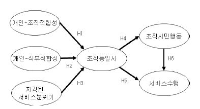
The purpose of this study is to empirically inquire into the relationship between a commercial sports center employee's person-environment fit(person-organization fit., person-job fit) & perceived service climate and organizational identification, organizational citizenship behavior and service performance through structural equation model analysis. For this purpose, this study conducted a questionnaire survey of 207 employees working at 12 commercial sports center(a facility in possession of more than 3 events). In an effort to verify the proposed structural model, this study used SPSSWIN Ver. 21.0 and AMOS 18.0. The research results are as follows: First, it was found that person-organization fit had an influence on organizational identification. Second, person-job fit was found to have an influence on organizational identification. Third perceived service climate was found not to have a positive influence on organizational identification. Fourth, organizational identification was found not to have a positive influence on organizational citizenship behavior, either. Fifth, organization identification was also found not to have a positive influence on service performance. Sixth, organizational citizen's action was found to have a positive influence on service performance.


This study was aimed at empirically analyzing the impact of conspicuous consumption of MTB club members and influence of the reference group on club identification, MTB attitude, and relation continuity intention through structural equation modeling. To accomplish the objective, 250 adult men and women who were involved in MTB clubs in Seoul, Gyeonggi, and Chungcheong areas were surveyed. As for sampling method, self-administered questionnaires were sent out through the mail, which were collected through visits. To verify the proposed structural model, SPSS WIN Ver. 21.0 and AMOS 18.0 were used. It led to the following results. First, conspicuous consumption didn't have a positive impact on club identification. Second, conspicuous consumption had a negative impact on MTB attitude. Third, the influence of reference group had a positive impact on club identification. Fourth, the influence of reference group had a positive impact on MTB attitude. Fifth, club identification had a positive impact on relation continuity intention. Sixth, MTB attitude had a positive impact on relation continuity intention.

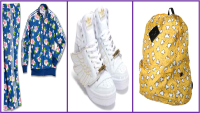
[Purpose] The present research aims to provide fundamental material required for establishing effective marketing strategies by analyzing purchasing experience of sports and art collaboration products and the determinants of purchasing intention. [Methods] Total of 370 survey questionnaires were distributed to undergraduate and graduate students in Seoul and Gyeonggi area and 331 questionnaires were analyzed as the final valid samples. For the data analysis, SPSS 18.0 version was used for frequency analysis, descriptive statistics analysis, exploratory factor analysis, reliability analysis, cross analysis, and logistics regression analysis. [Results] The study results are as follows. First, as a result of cross analysis on general characteristics, there was significant difference in age, monthly income and allowance, number of average purchases, considerations and major. Second, as a result of cross analysis on purchasing intention, there was significant difference in gender, monthly income and allowance, number of average purchases, considerations and major. Third, as a result of analyzing determinants of purchasing intention, there was significant difference in monthly income and allowance, number of average purchases, and sincerity. Fourth, as a result of analyzing determinants of purchasing intention, there was significant difference in gender, number of average purchases, considerations, major, creativity, aesthetics, interest and tenacity.

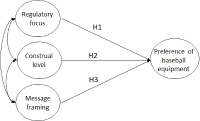
Purpose The purpose of this study was to analyze the propensity to consume the consumer of the baseball equipments who have difference of the product preference by regulatory focus, and who have construal level and suitable message framing. Methods Populations are consumers who have purchased the baseball equipments before, and the sampling groups, five different society baseball group’ league from Seoul and Kyeongi-do, were distributed, 318 copies, by convenience sampling. The questionnaire proceeded by three-way completely randomized design with stimulated sentences of four different advertisement compartmentalized by the regulatory focus, construal level and message framing. The analysis utilized SPSS 21.0 to perform the frequency analysis, manipulation check, independent t-test, two-way ANOVA, and Scheffe was used to post-hoc. Therefore, the result of this study is as below. Results First, after analyzing the distinction of the regulatory focus of the consumers of baseball equipments, the preference of the consumer who has improving focus was higher than that of consumer who has the prevention focus. Second, preference differentiation analyzed by construal level and the message framing of the consumer of the improving focus, the preference was higher when the message framing was positive, and the construal level was in short time. Third, preference differentiation analyzed by construal level and the message framing of the consumer of the prevetnion focus, there was no difference of the preference of the equipments followed by the construal level and message frame for prevention focus consumers.

The purpose of this study is to investigate the further direction of molecular biological studies, the advantages and limitations of assaying samples, and variables in figuring out the details of domestic and overseas studies verified through cell and molecular biological analysis in order to analyze the effect of concurrent training. The analysis study was limited to domestic and overseas literature, which investigated the effect of combined training using molecular biological analysis among studies to date. The study was reclassified by specialty, composed of professors of physical education and doctors of exercise physiology. The final selected study analyzed the subject and the trend of studies in terms of comprehensive perspectives. In detail, it analyzed hormonal and enzymatic changes in criteria such as leptin, 5-HT, ACTH(adrenocorticotropic hormone), cortisol, testosterone, GH(growth hormone), LDH(lactate dehydrogenase), CPK(creatine phosphokinase), antioxidants in blood samples and protein, and enzymatic and morphologic changes in for CRP, VEGF(vascular endothelial growth factor), PAI-1(plasminogen activator inhibitor-1), MAD(malondialdehyde), carnosin, and SDH(succinate dehydrogenase), the area of muscle fibers, ratio of type Ⅰ/Ⅱ muscle fiber and capillary proportion per muscle fiber in the extracted muscle by biopsy, for example. Finally, urine samples, and hormonal changes (like cortisol), were analyzed. The results of the analysis of domestic and overseas studies according to combined training has shown that this training has more varied effects than single training and lower improvement by interference effect or magnifying the effect of one type of training amongst the combined training types appears, rather than higher improvement through combined trainings. Therefore, it should be investigated in view of performance improvements relating to the characteristic of sports.

Purpose The purpose of this study was to examine the effects of temporal and spatial distance and types of advertising messages on sport consumer’s attitudes toward and advertising and purchase intentions, based on the construal level theory. Methods Toward this end, 253 usable data were conducted using frequency analysis, exploratory factor analysis, reliability analysis, correlation analysis, MANOVA, and ANOVA with SPSS 24.0. Results and Conclusion The study obtained the conclusion that when using different types of messages, the consumer’s attitudes and purchase intentions are influenced by temporal distance, by spatial distance, and by the interaction between both factors.

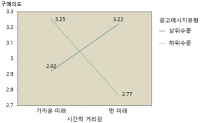


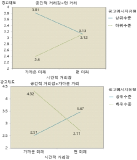



PURPOSE This study analyzed the relationship among coaching behaviors, motivational climate, sports competence, effort, and failure tolerance as perceived by high school athletes. Additionally, it examined whether motivational climate, competence, and effort mediate the relationship between coaching behaviors and failure tolerance. METHODS Using questionnaires measuring autonomy-supportive coaching behavior, controlling coaching behavior, motivational climate, sports competence, effort, and failure tolerance, 365 high school athletes were surveyed. Using SPSS 28.0 and Amos 28.0 software, descriptive statistics and structural equation modeling were conducted along with the following types of analyses: reliability, correlation, confirmatory factor, convergent validity, and discriminant. Additionally, the bootstrap method was used to verify serial multiple mediating effects. RESULTS Autonomy-supportive behavior had a significant positive effect 1) on motivational climate, sports competence, and effort and 2) on failure tolerance. 3) Controlling coaching behavior had a significant negative effect on motivational climate and sports competence. 4) Motivational climate and 5) sports competence both had a significant positive effect on effort. 6) Effort had a significant positive effect on failure tolerance. Last, in the relationship between autonomy-supportive behavior and failure tolerance, motivational climate, sports competence, and effort showed partial mediating effects. CONCLUSIONS This study confirms the importance of coaches’ autonomy-supportive behavior in determining failure tolerance among adolescent athletes. Based on this information, counseling (educational) programs aimed at enhancing performance can be developed and provided in sports settings, thus fostering success among athletes.
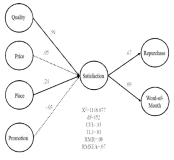
The purpose of this study was to examine the effect of marketing mix on satisfaction, repurchase intention, and word-of-mouth intention. Through the convenience sampling method, a total of 350 spectators from 2013 Son Yeon-Jae Gala Show. Of 350 surveys that were collected, 20 were discarded resulting in 330 usable surveys. By employing independent t-test, confirmatory facor analysis, structural equation modeling through SPSS 20.0 and AMOS 20.0, this study found followings. First, there was difference according to past experience of attending the gala show or watching it on media. Second, quality of performance and place in marketing mix were positively related to satisfaction. Third, satisfaction had a positive influence on repurchase intention and word-of-mouth intention. Fourth, quality of performance and place in marketing mix had a positive influence on repurchase intention and word-of-mouth intention mediated by satisfaction.
